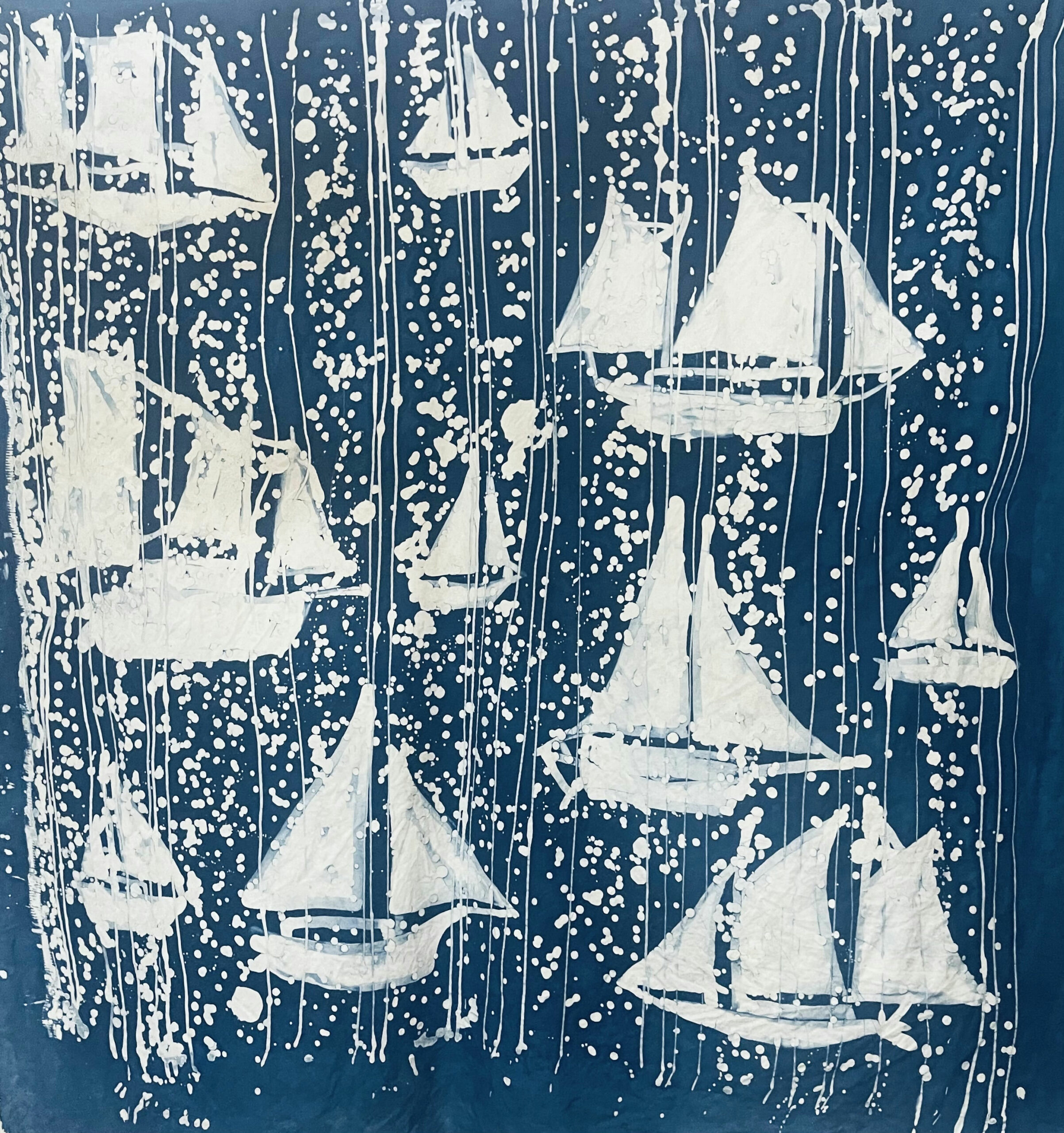‘DURING c.1700-1907 MACASSAN TREPANG FISHERS SAILED THEIR PERAHU TO THE NORTHERN TERRITORY COAST, (FORMERLY SOUTH AUSTRALIA) WITH THE AID OF THE DECEMBER NORTH-WEST MONSOON.’
$1,115
From 1700-1907 those Trepang (sea slugs/cucumbers) fishers travelled from Macassar in the Indonesian Archipelago and sailed to the Northern Territory coast in their wooden sailing vessels known as Perahu annually with the December north-west monsoon. There is nothing like sailing in a monsoon during the Dinah Beach wet season regatta from Stokes Hill Wharf. The downpours and then no wind just stillness… and the squalls.
Working with the Northern Territory’s unique past for 17 years has inspired this artwork. That and the love for dipping natural fabrics in Meng and Pam’s indigo vats once a month. Usually 10 times for that rich colour but here it is 5 times as the wax breaks down and you can loose the detail.
The upcycled queen sheet is from my mother-in-law Cob and Co Hotel that the family built and ran in Surat, Queensland, population 402. Those hotel sheets have lasted over 20 years.
Cob and Co hotel was built as there was a need to accommodate the influx of workers while extracting coal seam gas in the Surat Basin. It has been 100 years (August 2024) since the last horse-drawn Cobb & Co mail coach kicked up dust on the dirt track from Surat to Yuleba delivering to Pastoralists and small country towns.
The ‘Macassan’ trepang fishers who traded with local First Nations people including the Yolngu they left evidence that can be seen in the rock art with images of Perahu and objects such as clay pipes and giant trepang woks, and the introduction or iron for spears and tools and let’s not forget the tamarind trees. Trepang harvests, beeswax, pearl shells and ironwood went to traders from China upon the ‘Macassans’ return. The old horse-drawn cart traded in mail and delivered good. The Surat basin gas traded with China and the Eastern coast of Australia. The indigo dye trade started in China and was traded across the world.
Indonesian batik was added to UNESCO’s Intangible Cultural Heritage of Humanity list in 2009, and has been internationally recognised as an historical fabric of human civilization. It is thought to be over 1000 years old, with historical evidence pointing to its use in Africa, Asia and the Middle East. It is believed to have been transported to Asia by way of the Indian subcontinent. ‘Batik’ is derived from an Indonesian-malay word, referring to the wax-resist technique and the process of dyeing fabric. This includes covering areas of cloth with a dye-resistant substance in order to prevent color absorption. Those areas not covered are able to absorb deep hues. This wax was mixed with beeswax and petroleum based paraffin wax applying methods such as hand-painting with brushes and the tjanting tool method that you can see in the lines and the drips known as the splash method.
Thank you to Cycad Studio’s Meng and Pam for the use of their Indigo vat as part of the hand dyeing process and for boiling out the wax.
Wax-resist indigo-dyed up-cycled cotton textile with canvas lining
130 x 120cm
Artist Statement: Lisa Nolan studied Bachelor of Visual Arts at QUT specializing in conceptual art, sculpture, electronic installations using found objects and video art. After studying a Masters degree at the University of Melbourne she ended up working as the first paintings conservator at MAGNT for 15 years and now runs an Art Conservation Consultancy caring for the Northern Territory’s unique heritage through community engagement for truth telling, recommendations for historical collections, deceased estates and treatment of eclectic art collections far and wide.
Lisa’s art practice has focused on miniature paintings of the construction and deconstruction industry in Darwin and images snapped while sailing. Since the plague, Lorna Marlise and the Seagull catamaran crews left for less croc infested waters. Lisa enjoys experimenting and preparing different resist techniques whilst dyeing with indigo monthly at Meng’s bush block with Meng, neighbour Pam and her daughter Lucille.
Contact Tactile Arts on 08 8981 6616 or admin@tactilearts.org.au to purchase.


